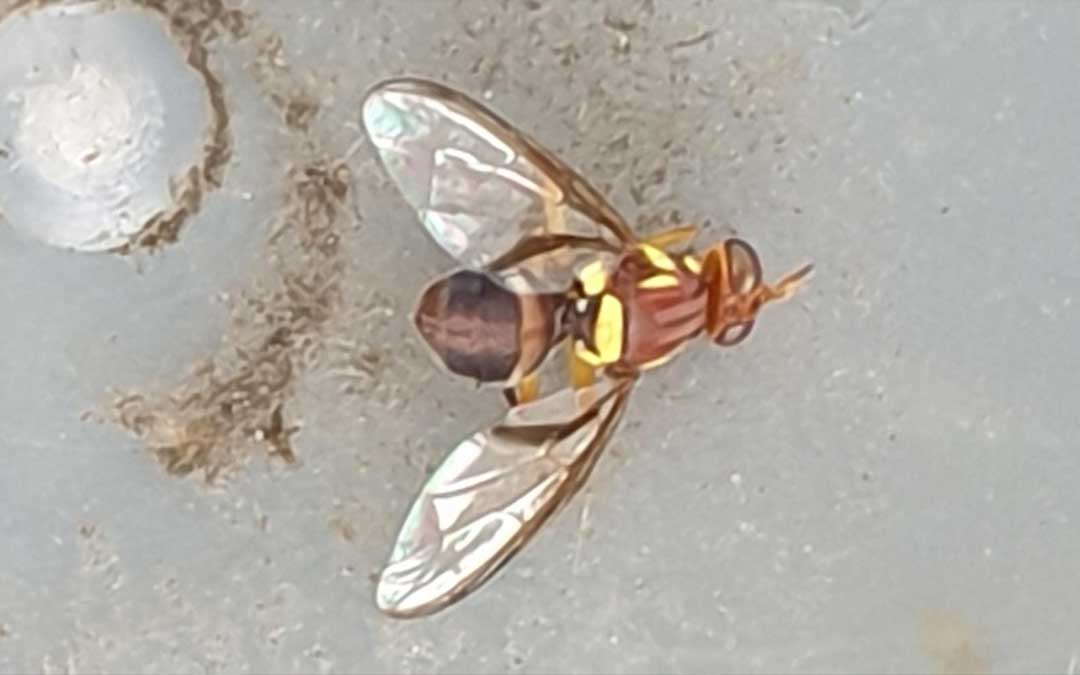Begin your Queensland Fruit Fly Prevention strategy NOW!

Now is the time to begin your campaign against Queensland Fruit Fly (QFF). Don’t delay! This pest is already the scourge of fruit and vegetable growers throughout the northern suburbs, but without doubt will extend its reach southward and to the east and west this season. The good news is that after a number of years trying to achieve QFF-free fruit and vegies, the Sustainable Macleod Community Garden did so last season. QFF was present – caught in lures and traps – but no produce was infested.
Here’s how it was done:
- August: all left-over fruit still on trees was removed excluding citrus.
- August onward: Lures filled with ‘Wild May’ fruit fly attractant were placed in fruit trees. The males are attracted to these and indicate the presence of QFF. Check them weekly, and top them up.
- September onward: Ceratraps were hung in trees. Ceratraps are a protein trap that attract both males and females. Ceratraps last 3-4 months depending on the climate before needing replenishment. Check them weekly to see if you have caught any QFF.
- September onward: the temperature at sunset was monitored. QFF mate at sunset when it is 16C or warmer. When this temperature occurs, it is an indicator that QFF may soon emerge and lay eggs.
- As soon as flowers on fruit trees were pollinated by bees etc., the trees (including all citrus) were netted with 2mm x 2mm insect netting, which was weighted down around the hem. All vegetables were netted when planted as most are self fertile, and also weighted down around the hem. It may be necessary to hand-pollinate eggplant, chillies and capsicums.
- Any fallen fruit was microwaved and disposed of in the waste bin twice weekly. None was put in the compost!
At Sustainable Macleod, we favour netting as our primary strategy. If QFF cannot get to the produce, then they cannot harm it. We use the lures and traps as backup and indicators of whether QFF is present.
Mistakes we made early on
Initially we made some mistake inlcuding: not weighing down net to prevent QFF from crawling under it; not netting early enough or not netting everything; pulling out spent plants with fruit on them, say chillies, and not disposing of them straight away or leaving them exposed on the compost; and not checking lures and traps despite our good intentions.
Starting early and being vigilant are the keys to success
You will not see any damage until you cut open ripe fruit or vegies such as nectarines, peaches, plums, apples, quinces, figs, pomegranates, tomatoes, capsicum, chillies and so on, so damage may be occurring right under your nose. Given the time and money we spend on our edible gardens, executing a strategy to protect our produce makes perfect sense, and we can succeed even if our neighbours are failing.
Where to obtain supplies
- Supplies are surprisingly hard to buy locally. As a service to the community Sustainable Macleod sells Wild May, lure bottles and netting at cost price. Go to our online shop to purchase.
- Ceratraps can be bought online in bulk quantities, so join together with friends to share the cost. The cheapest way to purchase it is to buy 5 litres and 20 traps for $210. Google ‘Ceratraps’ and look for the best deal.
- Net can be purchased from Bulleen Art and Garden or Sustainable Macleod. It is 6m wide and about $5 per metre. Avoid buying packaged net which is too narrow to do the job.
Note: Make sure any product you buy is specific for QFF and not just Fruit Fly. There are a number of ‘Fruit Fly’ products on the market, especially sticky traps that do not contain the pheromones which attract QFF and are therefore a waste of money and will not support your efforts to be QFF-free.
Written by Robin Gale-Baker
